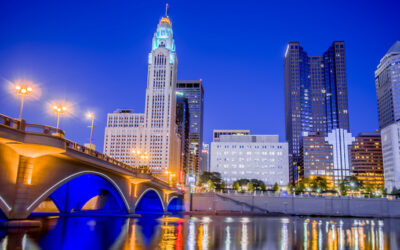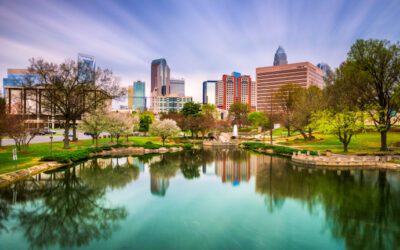When you think of Atlanta, perhaps you imagine a bucolic scene: The warm sun shining on your face as you stroll through an historic neighborhood where a lovely lady, sipping sweet tea on her front porch, shows you that Southern Hospitality by saying “bless your heart” and cheerfully inviting you up for a cold Coca-Cola.
But in reality, this is a sprawling metropolitan area with more than 5 million people in 14 counties that span 50 miles in each direction, and that lady is more likely behind the wheel of her car, sneezing from allergies, cranking up the air conditioning, screaming obscenities at a bicyclist, and stressing about what route to take to avoid the city’s horrific traffic.
So while Atlanta has its benefits, there are reasons to think twice about relocating to this fast-growing metropolitan area. Here are three:
The city is losing some of its charm.
Atlanta is made up of neighborhoods with distinctly different textures, from the peaceful, monied, leafy Inman Park to the rough-edged, eclectic, kooky Little Five Points. But some of the texture is at risk of being smoothed over, thanks to development and overdevelopment. Everywhere you look there are cranes, heralding the impending arrival of new condominiums. Developers wait breathlessly for a chance to knock down old bungalows and shops to build infill monstrosities and strip malls.
Above the @ClermontLounge, work is plowing ahead on the hotel’s transformation! https://t.co/EYJI6n5MTl pic.twitter.com/oLIAMnaV9K
— Curbed Atlanta (@CurbedAtlanta) February 9, 2017
Consider, for example, the Clermont Hotel. It’s being redeveloped into a boutique hotel with a rooftop bar. Nice, right? Wrong! Built in 1924 for $600,000 by an Atlanta businessman, the seven-story building was initially created to meet housing demand from middle-class professionals but eventually fell into disrepair and earned a reputation as a seedy place where you might get shivved. And that was part of its charm!
Another part of its charm: The Clermont Lounge, located underneath the hotel. It’s a place that’s uniquely Atlanta, a bar with strong well drinks and strippers who are older and wiser and rule the roost. (You’d never want to cross Blondie, who can crush beer cans with her breasts and has been known to use one to whack a patron across the face — for a fee, of course.) The new owners of the building say the Clermont Lounge will reopen and stay the same, but there’s skepticism, and concern that it will lose its dingy allure.
Cars are king.
Holy smokes, does Atlanta have bad traffic. You’d expect it during rush hour, of course. But try to get on the highways at, say, 1 p.m. and you’ll still encounter some good old gridlock. For no apparent reason. This is a city that has long operated under the assumption that 100 percent of its residents will travel by car. And when you’re on the roads, that’s definitely what it feels like.
Atlanta’s 1-285, 1-85 interchange “Spaghetti Junction” as ATRI’s top truck bottleneck for 2017 https://t.co/3dZlkYj7fZ pic.twitter.com/Jb1JEgSKfN
— Better Roads (@BetterRoads) January 28, 2017
The traffic is so bad, it’s award-winning, with the intersection of I-285 and I-85 — known as Spaghetti Junction — garnering the number one spot on the nation’s list of worst bottlenecks. Even the HOV lanes can move at a creep. When driving in this city, be sure to leave plenty of time to get to appointments — a three-mile drive can take an hour (it happens). You can try Uber or Lyft as a means to avoid some of the frustration, but for some reason our drivers frequently don’t know their way around the city and will rely on you to find the best route.
You’d rather ride your bike, you say? Pardon our laughter. Of the city’s 2.6 million commuters, just over 4,000 of them travel by bicycle — and they do so at their own peril. Only 84 miles of the city’s 1,584 miles of paved streets have bike lanes or trails, and Atlanta’s drivers are not known for sharing the road. There’s an effort underway to improve the situation, with a program called Connect Atlanta that would create 200 miles of bike lanes by 2030. But for now, cyclists are taking their chances in this car-centric city.
Public transportation, too, leaves something to be desired. The city’s train system, known as the Metropolitan Atlanta Rapid Transit Authority (MARTA), is popular for getting to and from the airport or around downtown and Midtown Atlanta. But the routes are very limited and the trains don’t run as frequently as they do in other urban subway systems.
Walking also has its limits in Atlanta. To be sure, the Atlanta BeltLine — a trail system on abandoned railroad corridors that will ultimately connect 45 intown neighborhoods with a 22-mile loop — has made the city a lot more walkable. But some neighborhoods don’t have sidewalks. Head out to the ‘burbs, and you’ll see very few souls on foot. Why? Like we said, they love their cars.
They call it Hotlanta for a reason.
24 and you still appreciate that baby pool in the Hot Atlanta Sun. #atlanta https://t.co/9VcBsDnfxY pic.twitter.com/OSqTdlAGjH
— Quarter Life* TV (@QuarterLife_Web) January 26, 2017
Well, honestly, locals don’t call it Hotlanta at all (nor do they call it “At-lan-Ta.” It’s “At-lanna.”) But they will admit that the temperatures, particularly in the summer, can feel downright scalding. The summer of 2016 was the city’s second-hottest ever, with day after day of humid 90-degree weather. The city went a whopping 73 days without temperatures dropping to 70 or below. By the year 2100, according to one study, the city could go for 94 days with the temperature above 95.
It’s lucky that just about everyone and every place has air conditioning. During the hottest days, locals take great care to spend mere minutes outside, going from their cooled homes to their cooled cars and their cooled offices, and so on.
Step outside, and not only will sweating commence immediately, so too might your sniffles. Because Atlanta is a hotbed for allergy suffering. We all carry a heavy coat of yellow dust on our cars during the blooming months, and just about everyone here is allergic to it. Even if you’ve never had allergies before, you’re likely to get the itchy eyes, the stuffy nose, and the scratchy throat if you move here. Locals would likely take issue with a recent study that showed Atlanta wasn’t one of the most challenging places to live with allergies. Allergies are a uniting problem in Atlanta…Like our losing sports teams. But don’t even get us started on that


